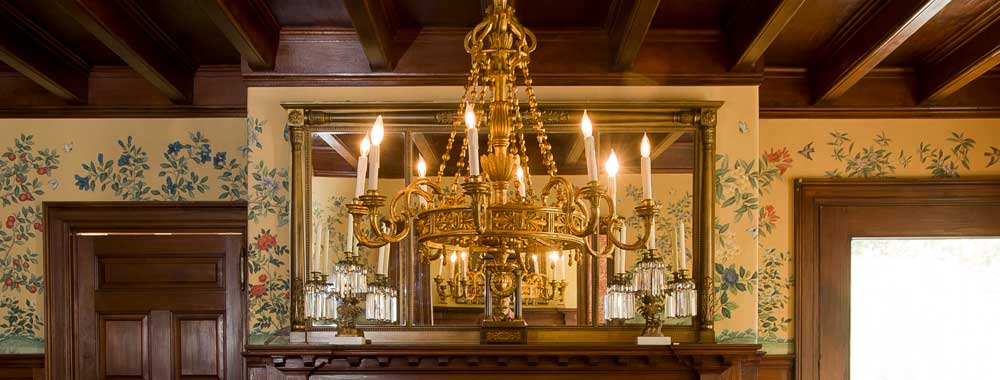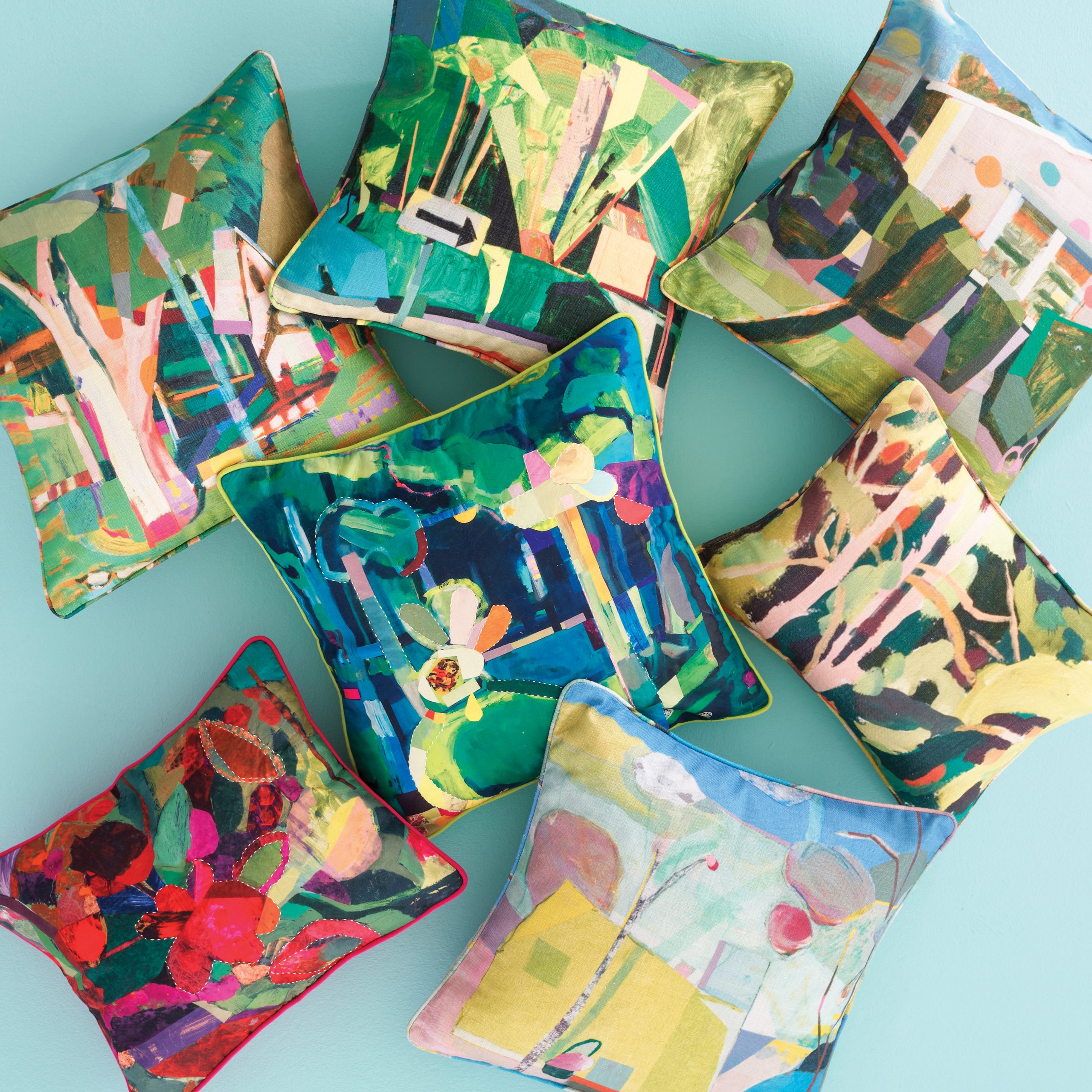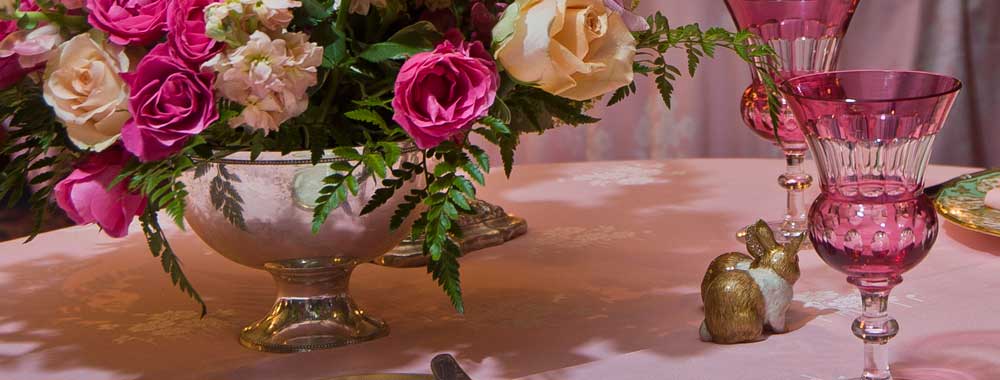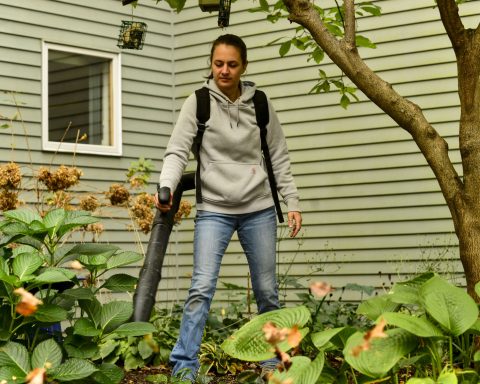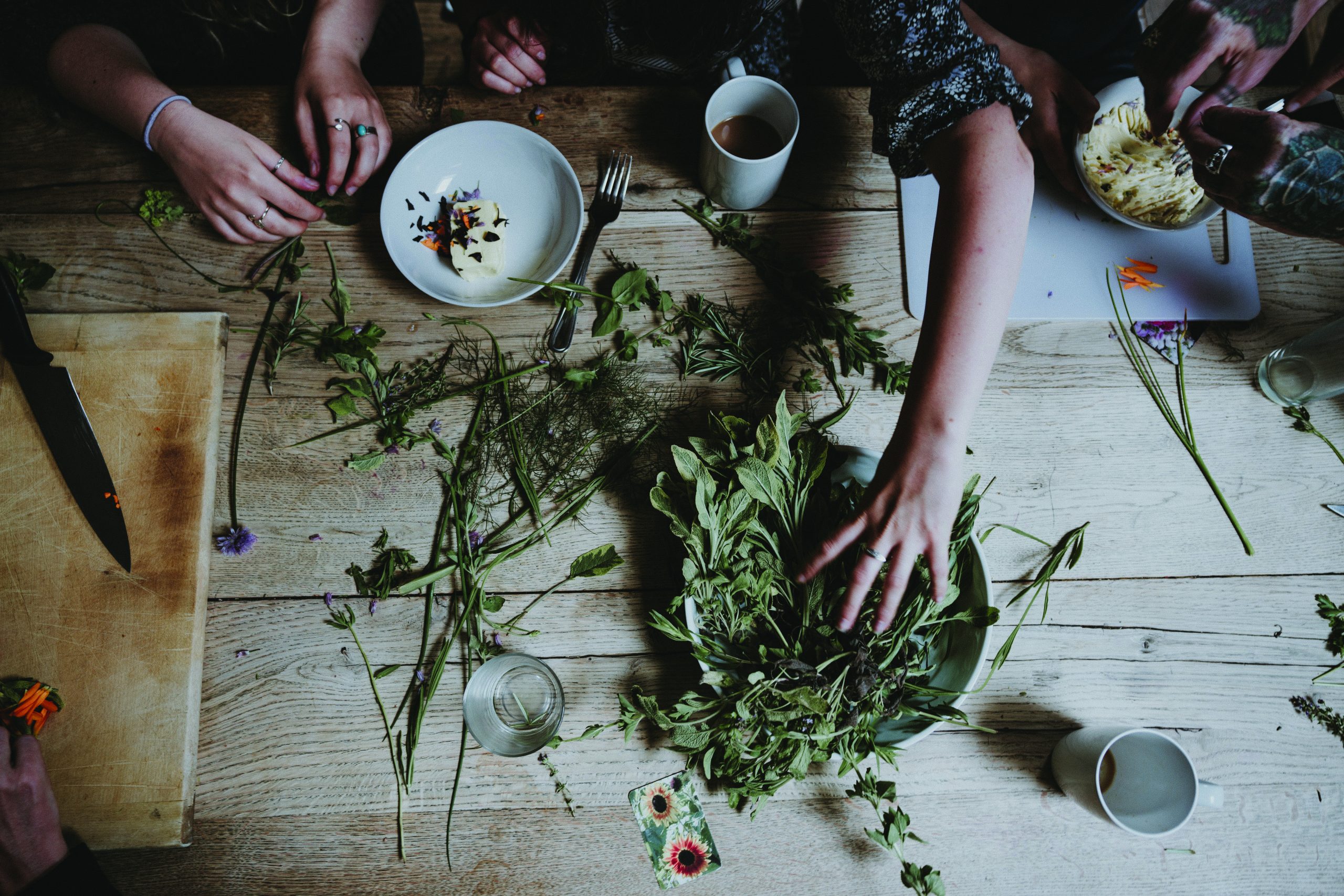
By Jennifer Huberdeau
It’s no accident that the binding on the stair runner carpet matches the wallpaper in the main hall and stairwell in Kate Morris’ Stockbridge home.
Attention to detail, no matter how minute, is something the interior designer, of Morris House Antiques & Interiors, takes very seriously, whether she’s working on plans for a Manhattan office or for her own Berkshire Cottage.
“I like people to walk into my rooms and feel a pleasing sense of symmetry, a balance in the color palette and in the proportions,” Morris said over an afternoon tea at her home, Cherry Hill, where she resides part-time with her husband, John “Hans” Morris, a co-owner of New England Newspapers Inc. The couple also has homes in New York City and San Francisco. “It’s also about layering — by that I don’t mean clutter or fussiness — and creating different levels of patina, so there’s interest in even small details in the room and the overall effect is pleasing.”
She isn’t one to design a room in a single time period or trend. For her, creating a comfortable yet elegant living space is about finding balance and harmony by blending traditional and contemporary styles. It’s an aesthetic known as “transitional.”
“I like to incorporate different styles and to try pull new pieces and cherished pieces together in a harmonious way. I really love incorporating the interests, passion and priorities of my clients into the decor,” Morris said. “I consider my style transitional. Transitional, to me, means pairing heirloom antiques with modern artwork, or vice versa, and creating spaces that appear timeless because of the reflection of different time periods and styles which compliment each other.”
“I play with pieces and texture and color and the rhythm of the architecture in the room to create an environment that reflects the people who own it and live there.”
It’s an aesthetic that appealed to clients in San Francisco, New York and the Berkshires, where she’s served as the interior designer for the 8,500-square-foot, 20-room Southmayd Farm mansion.
“Maybe it’s because of my eclectic interests or maybe I attract clients who want to work with a designer who will understand when they say ‘this isn’t the greatest Georgian table in the world, but it’s been in my family for three generations’ [and I want to keep it.],” she said.
The role of an interior designer is multifaceted, she says, describing it as part consultant, part project manager, part problem solver and sometimes mediator.
“For the most part, I find, people know what they like – they have favorite colors or favorite patterns or a favorite piece of furniture or style. As a designer, I’m often asked to help bring different points of view and different preferences together, so that everyone in the family is happy with his or her special place. And yet, we still have achieved a cohesiveness in the design. The goal is everybody be happy!” she said.
Dressed in black leggings and light blue denim shirt with a popped collar, Morris is enjoying a day at home with her American Kennel Club Grand Champion Vizsla, CH Auburn’s Dashing Dexter, just after the Thanksgiving holiday, which found the couple hosting some 22 guests at the estate.
It’s a far cry from the hustle and bustle of 1980s Wall Street, where both she and Hans worked. At the time of their marriage in 1984, Kate was an assistant vice president in the money-market finance division of PaineWebber Inc., while Hans was second vice president in the public finance division at Smith Barney, Harris Upham & Company.
It was during those early Wall Street days that her penchant for interior design took root.
“We were married very young and we worked long hours on Wall Street. On the weekends, before we had kids, we would go to museums, art galleries and flea markets and I guess I just started down a path where that was my hobby,” Kate said. “It gave me a creative release from the world of finance on the weekends. Spreadsheets just aren’t as pretty as chintz.”
Both she and her husband had grown up in households where art and antiques were held in high regard. Her husband’s grandparents, Vincent and Joan Morris, had retired to Stamford, Conn., where they opened Morris Antiques, specializing in early Americana, and taught classes in the trade. Joan Morris was a leading expert in Early American porcelain, authoring several books on the subject.
A native of Washington, D.C., Kate was raised to appreciate the wealth of history and art the region had to offer.
“I grew up living with antiques and things that were passed down through generations. I was always taught to venerate those things. My mother really loved art and art history, so my birthday parties wouldn’t be going to the ice skating rink. My birthday parties would be going to the Smithsonian or to the National Gallery of Art, to Mount Vernon or taking a trip to Williamsburg, Monticello or many of the smaller museums in and around Washington, D.C.
“I traveled to Europe with my parents as a child and my mother had to see every church, every castle, every estate, every museum. I had a really wonderful opportunity to grow up looking at beautiful things. I didn’t necessarily live with that kind of luxury, but I grew up appreciating beautiful things.”
The couple’s shared interests in antiques, history and art would unknowingly lead to Kate’s second career and lend itself to the later restoration of Cherry Hill and the historic Cherry Cottage.
“When I decided to retire from Wall Street, I found I had more time for my interest in interior design. Of course, most of my time was spent raising children, but eventually, in 2005, a friend of mine and I decided to go to the New York School of Interior Design together,” she said.
But she would soon find the skills she used on Wall Street would come in handy in her new profession.
“An important part of being a good designer is also being a project manager. That was a skill I carried over from my Wall Street days. I have been incredibly lucky in getting to know amazingly talented tradespeople in the Berkshires and people who travel all over the world to do their craft,” she said.

“A good designer knows the right people for the right job and is able to provide the organization skills and people skills needed to motivate and troubleshoot along the way. Part of the fun of working with a skilled team is that when issues arise, you have a lot of creative thinkers on site to solve the problem.”
Beginning in early 2001, Hans and Kate would first restore Cherry Hill, their Georgian Revival home which was built in 1897 for Dr. Charles McBurney and Margaret Weston McBurney, and then Cherry Cottage. Cherry Cottage, the original home on the property was built in 1783, has been called home by an eclectic group of individuals, including Norman Rockwell’s family, hippies and an astronaut.

“The most comprehensive work I’ve ever done was on Cherry Cottage. I literally oversaw that from the historical research stage on through. I was involved in everything from the historical research and architectural forensics to sourcing and reclaiming antique materials and managing a fantastic crew of carpenters, painters, plasterers, masons, etc. We had to make some really interesting choices because the house had been added on to so many times, as is typical in New England,” she said.
“In the end, we decided to pay tribute to the three most historical significant periods of the house — the colonial period, when the house was built; the federal period, when Theodore Sedgwick owned it and the 20th century, reflected in its modern, but understated kitchen and bathroom.) In the end, the house decorations really became a lot of fun, because I collected everything from antique beds and bureaus to antique spectacles and quill pens.”
Morris spent five years reclaiming 18th century floorboards, nails, hinges, doors and paneling. She then assembled a team of tradesmen, craftsmen and artists skilled in the correct time period of the house.
“I worked with some of the most incredible tradespeople and artisans, expert timber framers, highly skilled finish carpenters, decorative painters, mixing milk paints and glazes on site, master masons and plasterers. Our team was fantastic! What took the longest was finding the right people and the right materials, but patience paid off.”

Having the right skills and the right people in your Rolodex is only part of what makes a great designer, she says. It’s also about understanding a client’s needs and wants.
“Prioritizing things is different from one client to another. I like to consider lifestyle. Is this a young family? Is this a family with a lot of pets? With no pets? I think it’s important, obviously, to set a realistic budget, and also to make room in the budget to accommodate the wish list.”
She added, “Changes in lifestyle can be challenging for people, and more and more I’m working with clients who are downsizing or creating their second dream home to accommodate adult children and grandchildren. I find downsizing is particularly difficult for people. I think it’s an area where designers can be helpful because it’s so hard to edit oneself. It’s great to have somebody else say, that piece is a keeper but I think you can lose that. It’s very reassuring.”
To learn more about Morris House Antiques and Interiors, visit morrishousellc.com
6 Pro Tips from Kate Morris
Pro Tip: “Your windows are like framed artwork. When choosing colors, you need to consider the outside view.”
“If I’m designing in the Berkshires and I’m looking out at the view, I’m seeing lots of different shades of green. I may see an azure sky. I may see brilliant fall foliage. I see a panoply of texture and color. But, if I’m designing in San Francisco, I’m looking out at a waterscape. I’m seeing shades of gray and blue and very soft light. Not the brilliance of the array of color in the Berkshires. So that it informs the palette of my interior.”

Pro Tip: Morris says to “test your fabric and paint samples on the walls during different times of the day. It could be too dark a shade or too washed out.”
“Just because you like that color doesn’t mean it will look good in your room.”
Pro Tip: “I typically order 10 percent more than needed (with the client’s approval, of course!).” Morris says, “If you really love a wallpaper or a fabric, ask your designer or fabricator how much overage you should to have on hand for repairs — enough to make two extra pillows or to repair a leak.”
“There are so many product offerings today, and products tend to go out of stock or to become discontinued more frequently,” Morris said. “It can be very frustrating and costly if you have a spill or a leak and don’t have an extra quantity on hand to repair the damage and the product is no longer available.”
Pro Tip: Once you decide on the flooring, you’re better able to layer the room in terms of color, pattern and texture.
It’s fun to pick out colors and fabrics for a room first, but those first decisions will dictate the rest of the design.
“I think the most successful rooms start from the ground up. One of your biggest expenses is going to be your flooring – hardwoods, your carpets, your rugs,” Morris said.
“It’s not always the most fun to place to start, but it’s a good place.”
Pro Tip: “I like to lay all the pictures out on the floor in front of the wall they are to be hung on. Measure carefully, especially when you are creating a montage with different sizes and shapes of frames. Then you can play with the arrangement on the floor, before you pick up hammer and nails.”
Two is better than one when hanging pictures. Hanging a significant piece of artwork on a newly painted wall can be intimidating. Add a few more items, and the challenge increases. Don’t hang everything on the wall at the same eye level. You want to create movement on the walls.
Morris says, “So, before you put holes in the wall, have a plan.”
Pro Tip: Wine Off should be kept on hand. “When someone spills red wine, you spray it on and it takes the red wine out of the fabric or carpet.”
Any stain can be a pain to get out of fabrics and carpets, but red wine is one of the worst offenders.
Jennifer Huberdeau is New England Newspapers’ online editor and associate editor of UpCountry magazine. She also pens the column, “The Cottager,” for Berkshires Week and The Shires of Vermont.
